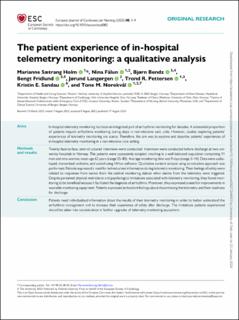| dc.contributor.author | Holm, Marianne Sætrang | |
| dc.contributor.author | Fålun, Nina Britt | |
| dc.contributor.author | Bendz, Bjørn | |
| dc.contributor.author | Fridlund, Bengt Gotthard Anton | |
| dc.contributor.author | Langørgen, Jørund | |
| dc.contributor.author | Pettersen, Trond Røed | |
| dc.contributor.author | Sandau, Kristin E. | |
| dc.contributor.author | Norekvål, Tone Merete | |
| dc.date.accessioned | 2024-01-24T07:09:27Z | |
| dc.date.available | 2024-01-24T07:09:27Z | |
| dc.date.created | 2024-01-16T09:24:45Z | |
| dc.date.issued | 2023 | |
| dc.identifier.issn | 1474-5151 | |
| dc.identifier.uri | https://hdl.handle.net/11250/3113439 | |
| dc.description.abstract | Aims:
In-hospital telemetry monitoring has been an integrated part of arrhythmia monitoring for decades. A substantial proportion of patients require arrhythmia monitoring during stays in non-intensive care units. However, studies exploring patients’ experiences of telemetry monitoring are scarce. Therefore, the aim was to explore and describe patients’ experiences of in-hospital telemetry monitoring in a non-intensive care setting.
Methods and results:
Twenty face-to-face, semi-structured interviews were conducted. Interviews were conducted before discharge at two university hospitals in Norway. The patients were purposively sampled, resulting in a well-balanced population comprising 11 men and nine women, mean age 62 years (range 25–83). Average monitoring time was 9 days (range 3–14). Data were audiotaped, transcribed verbatim, and coded using NVivo software. Qualitative content analysis using an inductive approach was performed. Patients expressed a need for individualized information during telemetry monitoring. Their feelings of safety were related to responses from nurses from the central monitoring station when alarms from the telemetry were triggered. Despite perceived physical restrictions and psychological limitations associated with telemetry monitoring, they found monitoring to be beneficial because it facilitated the diagnosis of arrhythmia. Moreover, they expressed a need for improvements in wearable monitoring equipment. Patients expressed ambivalent feelings about discontinuing the telemetry and their readiness for discharge.
Conclusion:
Patients need individualized information about the results of their telemetry monitoring in order to better understand the arrhythmia management and to increase their experience of safety after discharge. The limitations patients experienced should be taken into consideration in further upgrades of telemetry monitoring equipment. | en_US |
| dc.language.iso | eng | en_US |
| dc.publisher | Oxford University Press | en_US |
| dc.rights | Navngivelse-Ikkekommersiell 4.0 Internasjonal | * |
| dc.rights.uri | http://creativecommons.org/licenses/by-nc/4.0/deed.no | * |
| dc.title | The patient experience of in-hospital telemetry monitoring: a qualitative analysis | en_US |
| dc.type | Peer reviewed | en_US |
| dc.type | Journal article | en_US |
| dc.description.version | publishedVersion | en_US |
| dc.rights.holder | © The Author(s) 2023 | en_US |
| dc.source.pagenumber | 9 | en_US |
| dc.source.journal | European Journal of Cardiovascular Nursing | en_US |
| dc.identifier.doi | 10.1093/eurjcn/zvad082 | |
| dc.identifier.cristin | 2227400 | |
| cristin.ispublished | true | |
| cristin.fulltext | original | |
| cristin.qualitycode | 1 | |

